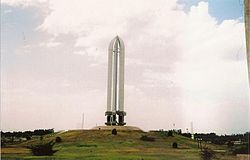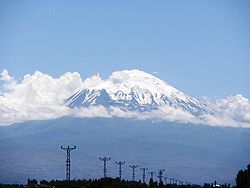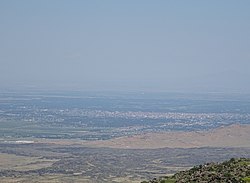Iğdır: Difference between revisions
→Genocide Monument and Museum: Pan-Islam in British Indian Politics (book) |
|||
| Line 181: | Line 181: | ||
| year = 1999 |
| year = 1999 |
||
| pages=41 |
| pages=41 |
||
| isbn = |
| isbn =9789004113718 }}</ref> |
||
It was completed on [[5 October]] [[1999]]. It is found on a 1,3 hectar area. Its height from ground is 43,5 meters and it is the highest monument in Turkey. Its bottom part is museum with 350 square meters area ad its upper part is monument consisting of 5 swords, which take the form of [[Mount Ararat]] in the background. The granite of the monument's swords were brought from China and other materials such as marble, granite, stone ceramics were brought from other regions of Turkey.<ref>http://www.ermenisorunu.gen.tr/english/massacres/igdir.html IGDIR GENOCIDE MONUMENT AND MUSEUM</ref><ref>http://www.igdirkulturturizm.gov.tr/BelgeGoster.aspx?F6E10F8892433CFFAAF6AA849816B2EFC6029A481C6EADF5</ref> |
It was completed on [[5 October]] [[1999]]. It is found on a 1,3 hectar area. Its height from ground is 43,5 meters and it is the highest monument in Turkey. Its bottom part is museum with 350 square meters area ad its upper part is monument consisting of 5 swords, which take the form of [[Mount Ararat]] in the background. The granite of the monument's swords were brought from China and other materials such as marble, granite, stone ceramics were brought from other regions of Turkey.<ref>http://www.ermenisorunu.gen.tr/english/massacres/igdir.html IGDIR GENOCIDE MONUMENT AND MUSEUM</ref><ref>http://www.igdirkulturturizm.gov.tr/BelgeGoster.aspx?F6E10F8892433CFFAAF6AA849816B2EFC6029A481C6EADF5</ref> |
||
Revision as of 19:36, 26 March 2009
Iğdır | |
|---|---|
 Location of Iğdır | |
| Country | |
| Region | Eastern Anatolia Region |
| Province | Iğdır |
| Government | |
| Area | |
| • City | 1,479 km2 (571 sq mi) |
| Elevation | 850 m (2,790 ft) |
| Population (2007)TÜİK | |
| • City | 119,432 |
| • Urban | 75,927 |
| Time zone | UTC+2 (EET) |
| • Summer (DST) | UTC+3 (EEST) |
| Postal code | 76000 |
| Area code | 0476 |
| Licence plate | 76 XX XXX |
| Website | Iğdır Municipality |
Iğdır (Armenian: Իգդիր) is the capital of Iğdır Province in Eastern Anatolia Region, Turkey, and borders Armenia, Azerbaijan and Iran. The border with Armenia is formed by the Aras River. Turkey's highest mountain, Ağrı Dağı, (the Biblical Mount Ararat) is in Iğdır province, but much of the land is a wide plain far below the mountain.
Etymology
The area's name came from "Iğdır Bey", the oldest son of Cengiz Alp who was one of six sons of Oghuz Han belonging to internal Oghuz three arrows branch considered to be the 21st of the 24 Oghuz branches.[1] They spread throughout Anatolia and there are towns and villages named Iğdır in Malatya and other parts of Turkey today.[2]
History
Historians believe that Igdir was known during the middle ages with the Armenian name of Tsolakert.[3] In 1555, Igdir became a part of Safavid Persia and remained so until it fell into the hands of the Russians after the Russo-Persian War of 1826-1828. Still a small village when it was incorporated, under Russian rule two primary schools, one for boys and one for girls, and three churches were opened and 100 Armenian families were allowed to move to Igdir. The town's population rose to 10,000 in 1914 and it largely busied itself with agriculture and trade.[3] As the Russian Empire collapsed in 1917, the land came under the control of the newly established Democratic Republic of Armenia. Under the boundaries drawn by US State Department in November 1920, Igdir, as a part of the district of Surmalu in the former Erivan Governorate, was envisaged to remain under Armenian control. But in September 1920, the Turkish forces led by Mustapha Kemal launched a war to eliminate the republic and managed to occupy Igdir.[4] As Armenia folded away to become a part of Soviet Russia, the Turks' territorial gains were confirmed in the 1921 Treaty of Kars.[3]
Geography
The city of Iğdır sits on a plain at a lower altitude than most of Turkey's eastern provinces. This allows agricultural production including apples, tomatoes, cucumbers, peaches, pears, sugar beet, watermelons and melons. However, the most famous produces of Iğdır are cotton and apricots.
Climate
Iğdır has a relatively moderate Continental climate. The climate is the warmest in this part of Turkey.
| Ortalama Veriler | |||||||||||||
|---|---|---|---|---|---|---|---|---|---|---|---|---|---|
| Months | Jan | Feb | Mar | Apr | May | Jun | Jul | Aug | Sep | Oct | Nov | Dec | |
| Average high °C | 2,6 | 5,6 | 12,8 | 20,1 | 24,3 | 29,4 | 33,7 | 34,4 | 29,1 | 21,2 | 12,6 | 4,9 | |
| Average low °C | -7,3 | -4,9 | 0,1 | 6,5 | 10,5 | 14,3 | 18,3 | 17,7 | 12,2 | 6,1 | 0,2 | -4,2 | |
| Average sunny day | 2,7 | 4,1 | 5,4 | 6,1 | 7,5 | 9,6 | 10,1 | 9,9 | 8,5 | 6,3 | 4,3 | 2,4 | |
| Average rainy day | 5,8 | 6,5 | 7,6 | 11,2 | 15,0 | 10,6 | 5,5 | 4,1 | 4,0 | 8,3 | 6,9 | 6,2 | |
| kaynak: www.meteor.gov.tr | |||||||||||||
Architecture
On the peninsula within a military zone stands Sürmeli castle, a medieval citadel whose surviving walls dating from 1224. The Armenian "Caravanserai of Zor" is another historical structure near Iğdır.[5]
Genocide Monument and Museum

On 1 August 1997, Turkish authorities inaugurated the construction of a monument and museum to commemorate the massacre of Turks[6] who were purportedly killed by Armenians during World War I[7][8][9] [10][11] [12]
It was completed on 5 October 1999. It is found on a 1,3 hectar area. Its height from ground is 43,5 meters and it is the highest monument in Turkey. Its bottom part is museum with 350 square meters area ad its upper part is monument consisting of 5 swords, which take the form of Mount Ararat in the background. The granite of the monument's swords were brought from China and other materials such as marble, granite, stone ceramics were brought from other regions of Turkey.[13][14]
Culture

Iğdır's culture is a subculture of the larger Culture of Turkey. The city's in the south of Caucasus position is central to many annual festivals.[15]
The agricultural production has caused the town to be livelier and wealthier than its neighbours in the generally impoverished eastern Turkey. There are many cafes and resaturants. The best-known dish is an oily meat stew called bozbaş.[16]
Media
Iğdır has 12 local daily and weekly newspapers.[17] The most prominent of these is Yeşil Iğdır which is published since 1 September 1955.
Economy
The city of Iğdır is located between Kars and Ağrı, and also neighbours with three countries; Armenia, Azerbaijan and Iran. Despite the fact that it has three strategically important neighbours, the border gates are held close, therefore this situation diminishes economic possibilities.
Almost seventy-four percent of Mount Ararat's area, the highest mountain of Turkey, stands in Iğdır's borders. But the investments for developing tourism in Mt. Ararat is paid to the Ağrı Municipality.
Demographics
Today, Iğdır has a mixed population of Kurds (who form the majority[18]), Turks, and Azerbaijanis.[19] The spring festival nevruz which is native to Iran is widely celebrated in Iğdır.

| Iğdır Centrum Population | |||
|---|---|---|---|
| 2007 | 75.927 | ||
| 2000 | 59.880 | ||
| 1997 | 44.334 | ||
| 1990 | 35.858 | ||
| 1985 | 29.460 | ||
| 1980 | 24.352 | ||
| 1975 | 29.542 | ||
| 1970 | 21.420 | ||
Famous people
- Avetis Aharonyan, chairman of the Democratic Republic of Armenia
- Drastamat Kanayan, an Armenian politician and general
- Servet Çetin, a Turkish-Azeri soccer player
- Şahin Yakut, a Turkish kickboxer and MMA Fighter
Sister cities
References
- ^ :: Iğdır Belediyesi ::
- ^ igdir köyü
- ^ a b c Anon. «Իգդիր» (Igdir). Soviet Armenian Encyclopedia. vol. iv. Yerevan, Armenian SSR: Armenian Academy of Sciences, 1978, p. 309.
- ^ Balakian, Peter (2003). The Burning Tigris: The Armenian Genocide and America's Response. New York: HarperCollins. pp. 324–330. ISBN 0-0605-5870-9.
- ^ Caravansarai of Zor. VirtualAni.org.
- ^ The Armenians in the late Ottoman period, page 149, The names of those who planned and carried out the systematic massacre of the Turks in eastern Anatolia are recorded in documents
- ^ http://www.hurriyet.de/haberler/son-dakika/200602/al-jazeera-film-documents-armenian-massacre-of-turks Al Jazeera film documents Armenian massacre of Turks
- ^ http://www.ermenisorunu.gen.tr/english/massacres/oba_village.html EXCAVATION OF THE MASS-GRAVE IN IGDIR - OBA VILLAGE
- ^ The Middle East - Page 303, Armenians committed genocides in 21 villages in the Igdir region alone
- ^ Ataöv, Türkkaya (2001). The Armenians in the late Ottoman period. University of Michigan: Turkish Historical Society. pp. 152–153. ISBN 9757479810. Oba is a village in the province of Igdir, south of the Aras River. ... This massacre is related to the one that took place in the latter village
- ^ Binark, Ismet (2007). Archive Documents about the Atrocities and Genocide Inflicted Upon Turks by Armenians. Indiana University: Grand National Assembly of Turkey Presidency of the Board of Culture, Arts and Publications. p. 134. ISBN 9756226331. The mass grave discovered in the village of Oba, Igdir
- ^ Qureshi, M. Naeem (1999). Pan-Islam in British Indian Politics, massacre of Muslims in the province of Van. BRILL. p. 41. ISBN 9789004113718.
- ^ http://www.ermenisorunu.gen.tr/english/massacres/igdir.html IGDIR GENOCIDE MONUMENT AND MUSEUM
- ^ http://www.igdirkulturturizm.gov.tr/BelgeGoster.aspx?F6E10F8892433CFFAAF6AA849816B2EFC6029A481C6EADF5
- ^ "Introduction of Iğdır", Iğdır Municipality Publishing, 2003
- ^ "Sürmeli Çukurda Iğdır", Ziya Zakir Acar, 2002
- ^ Her Yönüyle Iğdır", Ziya Zakir Acar, 2004
- ^ Distribution of Kurdish People — GlobalSecurity.org
- ^ Template:Tr icon Hürriyet
External links
- Official website of the Iğdır Municipality
- Template:Tr icon Official website of the Iğdır Province
- Template:Tr icon Iğdır's News website


